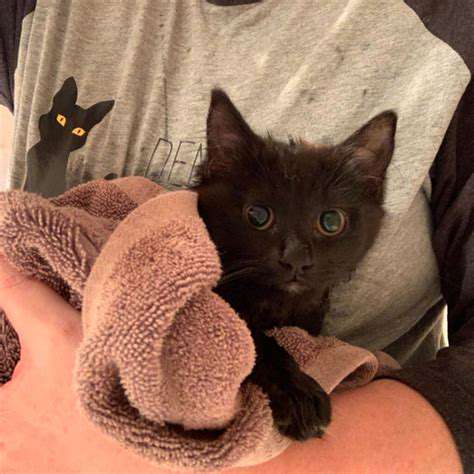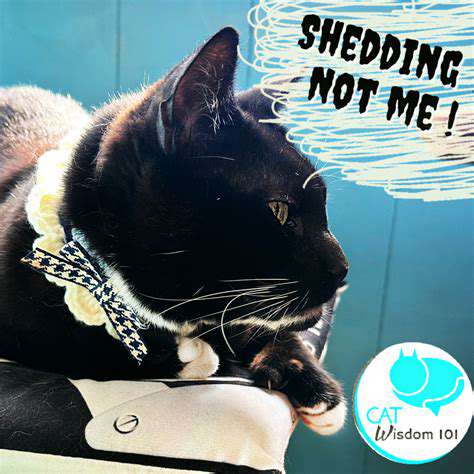Bathing Your Cat: Gentle Techniques
Understanding Your Cat's Body Language
Cats are masters of nonverbal communication, and recognizing their body language is crucial for a positive bathing experience. A relaxed cat is typically exhibiting soft, slow movements, with ears relaxed and not pinned back. Their tail may be gently swaying or resting, and their eyes might be open but not wide or staring. Conversely, signs of stress include arched backs, flattened ears, hissing, or twitching tails. Understanding these cues will help you gauge your cat's comfort level and adjust your approach accordingly.
Learning to interpret these signals allows you to anticipate potential distress and adjust your bathing technique to prevent negative associations. A calm, attentive cat is more likely to tolerate the experience with less anxiety.
Creating a Safe and Comfortable Space
The environment you create for the bath is just as important as the method you use. Choose a quiet, well-lit area with minimal distractions. This will minimize stress for your feline friend. A bathroom or a designated area with soft bedding or towels spread out can provide a sense of security for your cat. Having everything you need ready in advance will also help to keep the process moving smoothly and avoid unnecessary tension.
Preparing Your Cat Physically
Before introducing water, prepare your cat by gently handling them. This could involve stroking them, holding them briefly, and ensuring they are comfortable with your touch. This process helps build trust and familiarity with your touch before the bathing process. A calm, relaxed cat is more likely to tolerate the experience with less anxiety.
Using the Right Tools and Products
Selecting the right tools and products is essential for a safe and comfortable bathing experience. Choose a cat-specific shampoo and conditioner designed for their delicate skin. These products are formulated to maintain the natural oils in their coat, preventing dryness and irritation. Use a gentle, non-abrasive brush or sponge to avoid causing discomfort or injury.
The Bathing Process Itself
When introducing water, do so gradually, starting with a small amount of warm water. Use a gentle stream of water to wet your cat's fur. Avoid spraying water directly into your cat's face or ears. Apply the shampoo in a small amount to a damp area of fur and gently massage it into the coat. Rinse thoroughly with warm water, making sure to remove all traces of shampoo.
Post-Bath Care and Comfort
After the bath, thoroughly dry your cat with a soft towel or a hairdryer on a low setting. Make sure to keep them warm and comfortable in the immediate aftermath of the bath. Provide them with a warm place to rest. A warm blanket or a cozy bed can help soothe them after the experience. Rewarding them with a treat or a favorite toy can help reinforce positive associations with the bathing process.
Building Positive Associations
Consistency and patience are key to building positive associations with bath time. Keep the experience short and positive. Avoid making a big deal out of the bath. Making the experience a positive one will help your cat tolerate future baths. Making the process positive will ensure they are more receptive to future baths.

The Bathing Process: Step-by-Step Instructions
Preparing Your Cat
Before you begin the bathing process, it's crucial to Prepare your cat and your workspace. Gather all the necessary supplies, including a gentle cat shampoo specifically designed for pets, a soft towel, a non-slip mat or surface to prevent accidents, and lukewarm water. Having everything readily available will ensure a smoother and less stressful experience for both you and your feline friend.
Familiarize your cat with the bathing process gradually. Allow them to sniff and explore the shampoo, water, and towel, associating these items with positive experiences. Avoid harsh or sudden movements. If your cat is particularly anxious, consider consulting with a veterinarian or animal behaviorist for tailored advice.
Gathering Your Supplies
Thoroughly research and select a cat-specific shampoo designed to maintain your cat's natural coat health. Avoid shampoos formulated for humans as they can cause skin irritation and dryness. Use lukewarm water as hot or cold water can shock your cat and make them uncomfortable. A soft towel is essential for drying your cat and a non-slip mat will prevent slips and falls during the process.
Having a designated, well-lit area will improve visibility and safety. A quiet space with minimal distractions will help keep your cat calm and less likely to become stressed.
Wetting Your Cat
Gently wet your cat's fur, starting from the head and moving towards the tail. Use a gentle stream of lukewarm water from a spray bottle or a handheld showerhead. Avoid getting water in their ears, eyes, or nose as this can cause discomfort. Be mindful of your cat's body language. If they show signs of stress or discomfort, stop the process immediately.
Applying the Shampoo
Apply a small amount of cat shampoo to your hand or a damp cloth. Avoid directly applying the shampoo to the head, as it can irritate their eyes. Gently massage the shampoo into your cat's fur, focusing on areas that are particularly dirty. Make sure to avoid getting shampoo in your cat's eyes, nose, or mouth, as this can cause irritation.
Rinsing Your Cat
Thoroughly rinse your cat's fur with lukewarm water, ensuring all traces of shampoo are removed. Use a gentle stream of water to rinse away any remaining shampoo and avoid forceful jets. Pay extra attention to the areas where you applied the shampoo.
Drying Your Cat
Gently pat your cat's fur dry with a soft towel. Avoid rubbing, as this can cause irritation and lead to further discomfort. Wrap your cat in the towel to absorb excess water. If possible, consider using a hair dryer on a low setting to speed up the drying process. Always supervise your cat while using a hair dryer.
Post-Bath Care
Once your cat is completely dry, brush their fur to remove any tangles or knots. Praise and reward your cat for their cooperation. If your cat exhibits signs of anxiety or discomfort, consult a veterinarian or animal behaviorist. Ensure your cat is provided with a comfortable and safe space to rest and recover. If your cat seems uncomfortable or distressed, consult with a veterinarian.
Drying Your Cat: Ensuring a Warm and Comfortable Transition

Drying Your Cat Safely
Proper drying is crucial for a cat's comfort and health, especially after a bath or a swim in the rain. Rushing the process can lead to discomfort and potential skin issues. A gentle, thorough approach is essential, focusing on avoiding overheating and ensuring complete dryness, especially in areas like the ears and paws.
Using a hairdryer on a low setting can be effective, but always supervise the cat closely and avoid direct heat to sensitive areas like the face. Never use a hairdryer without proper supervision, as overheating is a significant risk.
Choosing the Right Drying Tools
Using soft towels, specifically designed for pets, can help absorb excess water efficiently. These towels are often made of materials that dry quickly and gently on the cat's skin. Avoid rough or abrasive materials that could irritate the cat's skin.
Consider using a low-heat, low-speed hairdryer for drying, which is a more efficient method to dry your cat, but always supervise your feline friend closely.
Preparing Your Cat for Drying
A calm and relaxed cat is more likely to tolerate the drying process. Ensure the environment is quiet and comfortable. Distraction techniques, like offering a favorite treat, can help ease anxiety.
Be patient and gentle. Avoid sudden movements or loud noises that could startle your cat. A calm and soothing environment is crucial for a successful drying experience.
Drying Techniques for Different Areas
Pay extra attention to areas like the ears and paws, as these are more vulnerable to moisture retention. Gently pat or blot these areas with a soft towel to remove excess water.
Avoid rubbing the fur too aggressively, as this could cause skin irritation. Instead, gently dry the fur in a smooth, controlled manner. Thorough drying is essential to prevent skin infections.
Drying Your Cat's Coat
Use soft, gentle strokes to dry the coat, following the natural direction of the fur. This helps to distribute the moisture evenly and prevents tangles. Regular grooming is vital to maintain a healthy coat and to prevent mats. This is especially important after a bath or a swim.
Make sure to dry the undercoat thoroughly. This is often overlooked, but it's essential to prevent moisture from trapping beneath the fur and causing discomfort. Ignoring this can lead to skin problems.
Post-Drying Care
After drying, inspect your cat for any signs of discomfort or irritation. If you notice any redness, swelling, or excessive scratching, consult a veterinarian immediately. Proper drying care is crucial to maintain your cat's overall health and well-being.
Consider using a post-bath moisturizer, which can help soothe any dryness and maintain the skin's natural oils. This step is often overlooked, but it can make a significant difference in your cat's comfort.

Read more about Bathing Your Cat: Gentle Techniques
Hot Recommendations
- Best Pet Bowls: Stainless Steel and Ceramic
- Pet Hydration: Why It's Crucial
- Stop Counter Surfing: Training Your Dog to Stay Off
- Pet Hypothyroidism: Symptoms and Management
- Signs of Pet Liver Disease: What to Watch For
- Pet Emergency Kits: What to Pack
- Dangers of Xylitol: Toxic to Dogs
- Dealing with Pet Diarrhea: When to See a Vet
- Preparing Pets for Travel: Tips for a Smooth Trip
- Pet Depression: Recognizing the Signs











